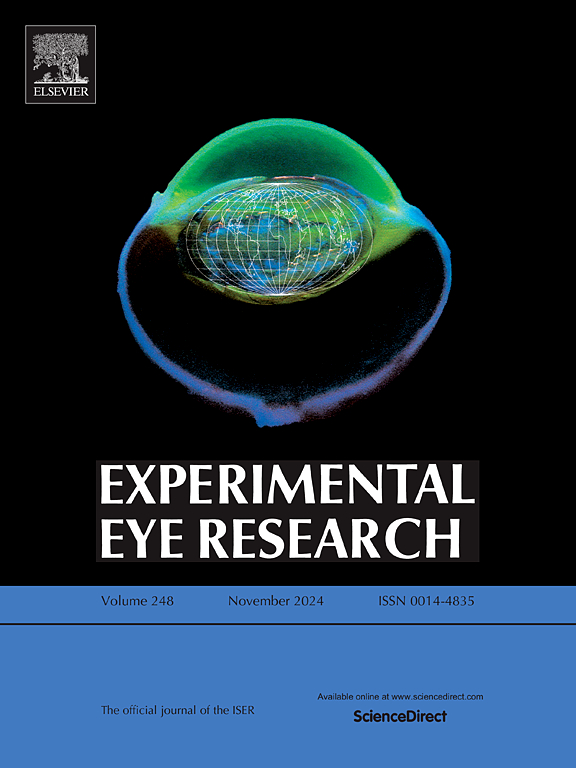眼及眼病中含有核蛋白相关蛋白的PEST蛋白水解信号研究进展
IF 3
2区 医学
Q1 OPHTHALMOLOGY
引用次数: 0
摘要
人类的视觉系统是理解我们周围世界的关键组成部分,但它受到各种眼睛状况的影响,导致视觉障碍。全世界有超过22亿人患有黄斑变性、屈光不正、白内障和青光眼等视力问题。在虹膜学领域,维持健康眼睛活动的必需蛋白质经常发生突变或失调。清晰的视力对人类至关重要,与这些蛋白质相关的突变可以显著影响眼部疾病的流行和发展。本研究检测了与眼部疾病相关的蛋白质,包括核蛋白Ras、s -谷胱甘肽化、人类ER1蛋白和含有害虫蛋白水解信号的核蛋白(PCNP)。确定和研究潜在的治疗靶点和策略来调节这些蛋白质的功能对于最大限度地减少眼部疾病的患病率至关重要。PCNP与几种眼部疾病的发展特别相关。有效治疗眼部疾病的临床策略的发展将受益于对这些分子过程的理解。本研究的重点是PCNP,因为它在眼部疾病的病理生理中起着重要作用。了解这种蛋白的功能是至关重要的,因为它的失调与几种眼部疾病有关。充分了解这些必需蛋白的作用对于制定有效的眼病治疗和预防措施具有重要意义。因此,本综述旨在通过影响如何靶向和调节这些前瞻性补救措施的想法,促进全球可预防性失明和视力损害的研究、治疗和管理的进展。本文章由计算机程序翻译,如有差异,请以英文原文为准。

PEST-containing nuclear protein in eye health and disease: A review
The human visual system plays a crucial role in how we perceive the world. However, it is susceptible to ocular conditions that can result in visual impairments. Globally, over 2.2 billion people suffer from vision impairments, including macular degeneration, refractive errors, cataracts, and glaucoma. In the field of iridology and ocular biology, essential proteins governing ocular homeostasis are frequently mutated or dysregulated. Clear vision is essential for people, and mutations related to these proteins can significantly impact the prevalence and progression of eye disorders. This review discusses proteins linked to ocular disorders, including the nuclear protein Ras, the human ER1 protein, and the PEST-containing nuclear protein (PCNP). Identifying and studying potential therapeutic targets and strategies to regulate these proteins is crucial for minimizing the burden of eye disorders. PCNP has been specifically linked to the development of several eye disorders. An understanding of these molecular processes will facilitate the development of clinical strategies to treat ocular disorders effectively. The main focus of this review is PCNP because of its significant role in the pathophysiology of eye disorders. Dysregulation of this protein has been linked to several ocular diseases, highlighting the need to clarify its functions. A comprehensive understanding of these essential proteins is vital for developing effective treatments and preventive measures against ocular pathologies. This review aims to advance global research, treatment, and management of preventable blindness and vision impairment by exploring strategies to target and regulate these potential therapeutic candidates.
求助全文
通过发布文献求助,成功后即可免费获取论文全文。
去求助
来源期刊

Experimental eye research
医学-眼科学
CiteScore
6.80
自引率
5.90%
发文量
323
审稿时长
66 days
期刊介绍:
The primary goal of Experimental Eye Research is to publish original research papers on all aspects of experimental biology of the eye and ocular tissues that seek to define the mechanisms of normal function and/or disease. Studies of ocular tissues that encompass the disciplines of cell biology, developmental biology, genetics, molecular biology, physiology, biochemistry, biophysics, immunology or microbiology are most welcomed. Manuscripts that are purely clinical or in a surgical area of ophthalmology are not appropriate for submission to Experimental Eye Research and if received will be returned without review.
 求助内容:
求助内容: 应助结果提醒方式:
应助结果提醒方式:


